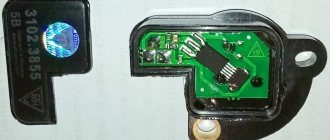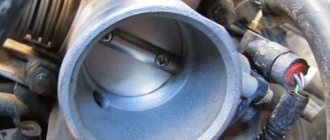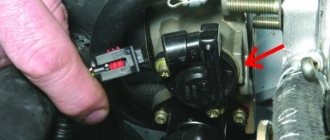Statistics show that problems with the throttle position sensor often occur on VAZ 2114, 2110, 2112, Kalina, Niva Chevrolet, Priora cars. As a rule, this is indicated by error code p0120, but not always (this point is discussed in detail below). By the way, other cars are also not insured against such a breakdown.
Code p0120 means that there is a problem in the electrical circuit between the TPS and the ECU, but it does not indicate a malfunction of the device itself. Therefore, next we will talk about the signs and causes of TPS malfunction, which are typical for all cars with an injection power system.
What affects the operation of the throttle position sensor?
TPS (another name for TPS) is designed to determine the position angle of the throttle valve (installed on its axis) and transmit the readings taken to the ECU. It also monitors the speed of movement of the damper (when the gas pedal is pressed sharply) and the moments when it is in its extreme positions.
A lot depends on these readings - the electronic control unit, based on the data received, forms the correct ignition timing under certain engine operating conditions, and issues commands to supply fuel in the required dosage. All this affects the formation of the optimal fuel-air mixture, and, accordingly, the power performance of the engine.
Also, based on the data received, the ECU adjusts the operation of electronic systems: ABS, ESP, cruise control, traction control and others.
The main signs of failure of the TPS
If the device is faulty, then error p0120, which was mentioned above, may appear, as well as other errors indicating that there are deviations in the operation of the sensor: P2135, P0222, P0122, P0223, P0123, P0220, P01578. The errors themselves are not displayed on the dashboard, only the “Check Engine” light comes on, they can be seen on diagnostic scanners, mobile devices or a laptop (more on this later).
As for error P2135, it is typical for modern cars with electronic remote control position control. Its full name is “Mismatch of readings from sensors No. 1 and No. 2 of the throttle position.” Occurs when there is increased resistance in the circuit of one of the wires (there are four of them). About its reasons in the next section.
Other signs of TPS malfunction:
- Floating speed, at idle the car shakes violently or stalls. A sharp jump in rpm up to 2000 - 3000.
- The dynamics of the car drops, especially during acceleration (dips, jerks), towing, climbing a mountain, transporting goods; as people say, the engine does not pull. This also happens due to the unstable operation of the automatic transmission, everything is interconnected. Or, conversely, when you press the gas pedal slightly, the car accelerates sharply.
- Increased fuel consumption - appears immediately after the sensor malfunctions.
- When shifting to a higher or lower gear, including neutral, the engine stalls.
- The machine switches to emergency mode, the crankshaft rotation speed does not exceed 1500 rpm, since the damper in this mode is only slightly open by 6-7%.
The same signs indicate a malfunction of the throttle valve, the condition of which is important to periodically check and, if necessary, clean.
When cleaning is required
It is recommended to clean the damper every 65 thousand kilometers. But how can you determine that the unit needs it now, even though you have driven no more than 40 thousand kilometers?
Clogging occurs due to dust, oil, and gases from the crankcase. All this settles on the walls of the device, so the damper does not open or close properly.
There are several symptoms that can help you accurately determine the need to clean the damper:
- The engine starts every once in a while;
- At idle, the speed starts to jump;
- The engine starts, but immediately stalls spontaneously;
- The crankshaft rotates at an increased frequency;
- At low speed the car seems to jerk.
If you undertake cleaning, be sure to check the throttle sensor on the VAZ 2114, the symptoms of which are similar to those described above. Plus, the idle speed and air flow sensors are checked.
Operating principle of TPS
Throttle position sensors are divided into two types: contact and non-contact. They are different in design, but the methods for testing them are the same. Their drive can be mechanical or electrical.
The first mechanical ones (film resistive or potentiometers) are a slider with contacts placed on it.
The throttle valve, through the drive and gear with the shaft, changing its position (angle of inclination) moves the slider along the resistor tracks. Based on the voltage from 0.7 to 4V (varies due to changes in the resistance of the resistor tracks), the ECU understands where the damper is located and adjusts the fuel supply.
Those. increasing the angular position of the damper increases the DC voltage value and vice versa.
When the driver just turns on the ignition, the ECU receives data from temperature sensors about the degree of engine warming up. Based on this, the throttle valve is set to the pre-start position at a certain angle.
For example, on the Lada Priora and Kalina, where there are two TPS (in cars with an electronic throttle pipe module), at this moment the output signal voltage should be:
- The first output is in the range of 0.39-0.52V.
- The second is 2.78-2.91V.
For each car brand, these indicators may differ, but if we consider the above models, then the following happens:
- If after turning on the ignition within 15 s. nothing happens (the gas pedal is not depressed, the engine does not start), the ECU turns off the electric throttle drive, and the throttle drops to 7%.
- 30 seconds after the ignition is turned on and the driver is inactive, the ECU closes the damper completely and then returns it to the pre-start position.
In this case, the signal output voltage is equal to:
- In the first case, 0.5-0.6V.
- In the second - 2.7-2.8V.
If there is a break in the throttle sensor circuit, the ECU turns off the throttle drive and stores an error code in the memory.
Also, on cars with two TPS, as is the case with Lada Priora and Kalina, their total signal output voltage should not exceed 3.2-3.4V.
The operating principle of non-contact (magnetoresistive TPS) is based on the magnetic-resistive effect - they rarely fail, due to the absence of contacts rubbing against each other. For this reason, they are more reliable and last longer, although they are more expensive than contact ones.
Common causes of malfunction are short circuits in electrical circuits, broken wiring.
Causes of malfunction of contact sensors
The main reason for failure is wear of the resistive tracks, leading to a complete or partial break in the electrical circuit. This leads to the transmission of incorrect data to the ECU.
Causes of malfunction of contact sensors:
- Wear of the resistor layer leads to loss of electrical contact. This can happen either at the beginning of the slider’s movement (typically when the voltage at the sensor output is low), or on another section of the tracks.
- Broken or worn tip.
- Wear of drive gears.
- Short circuit of signal or electrical circuits.
- Broken wiring, especially for VAZ cars, whose wires are not reliable.
- Oxidation of contacts and contamination of connectors.
Most causes can be diagnosed visually after disassembling the device and using a multimeter.
Regarding error P2135, which was mentioned in the previous section, its causes:
- poor ECU contact ground;
- oxidation of contacts in the connector;
- main relay malfunction;
- short circuit and other reasons.
MUST WATCH VIDEO:
If the driver is attentive to the behavior of his car and constantly monitors the performance of the car’s electronics and engine, then he can be confident that no surprises await him on the road. You must constantly remember that your car will serve you for a long time and faithfully only if you take care of it and its insides. Any car loves care, even after leaving the car wash you can feel how softly the engine starts running and how smoother the car drives on the road.
Troubleshooting Throttle Sensor
The first thing you need to understand is that if the throttle position sensor fails, then it cannot be repaired, but must be replaced as an assembly.
Diagnostics is carried out with a multimeter by measuring DC voltage or resistance in the circuit; a scanner is also used.
At the initial stage of checking the TPS, you will need a multimeter to measure voltage readings (supply and signal).
Test with a multimeter (preferred method)
Check procedure:
- Turn on the ignition.
- Check if power is supplied to the sensor. To do this, disconnect the chip and measure the voltage readings on the wires suitable for the sensor. To do this, set the switch on the device to the “20V” position and take the readings (the norm is 4.5-5.5V). If there is no voltage, then we look for an open circuit or another reason.
- We check the presence of signal voltage coming from the sensor to the computer when the damper is fully closed and open. To do this, set the “-” of the multimeter to ground (engine block or battery), and connect the “+” to the third signal contact. When the throttle is closed (the gas pedal is depressed), the voltage should not exceed 0.6-0.7V. When fully open (the accelerator is fully depressed) - at least 4V.
- Next, we check for the presence of surge voltage when moving the damper between the “closed” and “fully open” positions. To do this, use an additional wire, which you insert into the Pin of the wire going to the ECU, and connect the other end to the plus of the device. Place the contactor back on the sensor. Gradually press the gas pedal or pull the cable and monitor the instrument readings. The voltage should increase and decrease smoothly. If jumps in U occur, this means that the resistor tracks have worn out in some places and the TPS must be replaced.
You can also check the sensor by measuring its resistance. For this, a multimeter switched to the appropriate mode is also used. Readings are taken between the negative and signal contacts. For ease of work, the product can be removed.
Standard readings for VAZ models:
- The damper is closed – 1.5 kOhm.
- Open – 7.5 kOhm.
For example, the Niva Chevrolet has different regulatory indications:
- The damper is closed – 2.4 kOhm.
- Open – 8.2 kOhm.
Therefore, see the operating and repair manual for your car model for voltage and resistance data.
The process of changing resistance should also occur smoothly without jumps. To do this, rotate the sensor mount.
Also read about the signs of a malfunctioning mass air flow sensor.
Checking with a diagnostic tool
The words “diagnostic tool” sound loud, but in fact, it will be enough to purchase an ELM327 auto scanner or Scan Tool Pro running on the same chip and install special software, for example, OpenDiag, on a smartphone (Android) or iPhone (iOS).
You can also carry out a complete diagnostic of the car via a laptop. Or use the AVTOAS-F16 CAN multi-system scanner.
By clicking on the links above, you will receive comprehensive information on how to connect to the diagnostic connector, what software to use and much other useful information on this topic.
But in short, the essence of using scanners is to connect to the computer and, using special software, see the error numbers registered in it.
Connection is possible via: USB cable, WI-FI, Bluetooth. But it is important to know that some ECUs, especially on older cars, do not support WI-FI and Bluetooth protocols and the ELM327 scanner can only be connected to them via USB with a USB to MicroUSB Adapter. Accordingly, you need to purchase a wired scanner model.
It is better to use scanners with a 32-bit chip; they provide more opportunities for diagnosing a car.
Possible errors associated with the TPS and the electrical circuit were mentioned above, but other errors associated with unstable operation of the engine and electronic systems of the car may also be registered in the ECU. Some of them can be reset, for example, “motor overheating”.
The advantage of using a scanner is monitoring the operation of the sensor in real time. To do this, turn the throttle while squeezing the gas pedal. The program will display changes in voltage and inclination angle. Sudden voltage surges will indicate a problem.
Checking the throttle position sensor at home
For example, you removed the sensor and brought it home (it’s cold in the garage in winter).
To check it you will have to get a 5V power supply. A power supply from a stationary PC is perfect, but make no mistake, there are also 12V connectors. Or a regular mobile charger.
Check procedure (wire pinout above):
- Set the multimeter to DC voltage measurement mode up to 20V.
- Connect the “-” sensor wire from the power supply and the negative probe from the device to the “-” wire.
- We connect “+” from the power supply to the “+” wire of the sensor.
- We connect the “+” from the multimeter to the signal wire of the TPS.
- Rotate the slider with a screwdriver or any other available method.
Standard voltage readings should be the same as indicated in the sections above - from 0.7 to 4V.
Electronic gas pedal VAZ 2114: advantages of use and principle of operation
Since 2011, all cars produced by the AvtoVAZ concern are equipped with an electronic gas pedal, including VAZ 2114 models produced after 2011. The e-pedal has many advantages, but also due to the novelty of the mechanism used for AvtoVAZ, there were a number of shortcomings. Many motorists who bought a car with e-gas VAZ 2114 encountered problems after some time.











